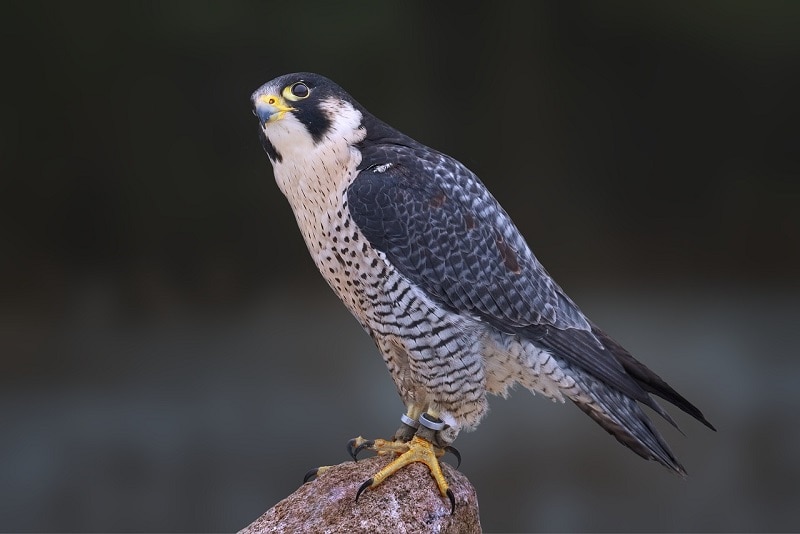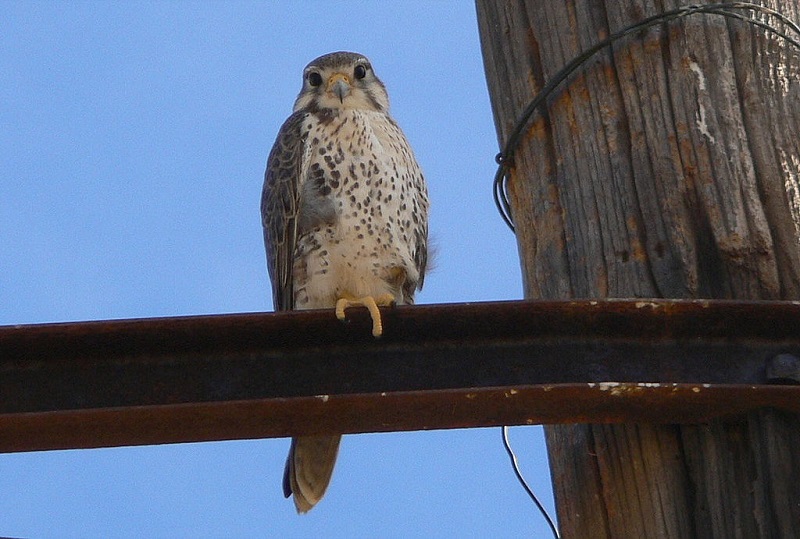5 Types of Falcon Species in the United States (With Pictures)
Last Updated on

When you think of a falcon, what comes to mind? Is it this majestic bird that can travel at high speeds? There are 5 species of falcons that reside in the United States. Each one has its own way of living that makes the bird watching experience worth it.
Take a look at the 5 falcons that call the United States their home.

The 5 Types of Falcon Species in the United States
1. Merlin

Starting off this list, we have the Merlin. While on the smaller side of the falcon family, we still know them to pack a punch when hunting. They are keen hunters that use their small size to sneak attack their prey.
The males of this species are darker, a more silver a richer cream stomach with the signature brown spots, while the females are a brighter gray with a white abdomen and brown spots. The unique thing about these birds of prey is that their coloring is going to vary from range to range.
If you are looking for a Merlin, you are in luck. Their range is all over the United States and their habitats reflect the area they are in. What you need to watch out for is migration. These are one of the few birds of prey that migrate south when temperatures drop. Those who live in Montana and upper Wyoming will find that the Merlin sticks around year-round.
There are two simple ways to identify this bird: the rabid wing beats and its size. Don’t let that fool you though, these birds have attacked trains and cars that enter their territory.
Their diet is a variety of mammals, other birds, insects, and fish.
Merlin’s don’t build their own nests either. Like most falcons, they refuse abandoned nests from various types of birds. The favorite nests are from magpies, crows, or hawks.
Here are the typical measurements of the Merlin:
- Length: 9–13 inches / 23–33 cm
- Weight: 4.4–10.6 oz. / 125–300 gm
- Wingspan: 21–23 inches / 53–58 cm
2. American Kestrel

Coming in at the smallest falcon in the United States is the American Kestrel. You may know this falcon by its nickname, the Sparrow Hawk, which it gets from taking sparrows and other birds out of the air during hunting. It may be small, but this bird doesn’t hold much fear.
The American Kestrel is one of the most common falcons to see from anywhere in the United States. Most of the states will see this bird all year. Texas, the lower part of Louisiana, and the tip of Florida are more likely to have sightings in the winter. The northern states will have more sightings during the summer months.
If you see a bird hovering in the breeze from a low height, chances are you are witnessing the American Kestrel hunting. The diet of these birds is so diverse that it is one of the many reasons it can live just about anywhere. The typical menu items are small rodents, insects, inebriates, and small birds.
The downside to being the smallest falcon is they are often eaten as prey by larger birds and corn snakes.
When spotting the falcon, it is easy to tell the males from the females. Females are going to have rust colored wings and backs with brown barring. Their bellies are going to be a tan or buff color with bring streaks. Males are going to have blue or gray wings with white bellies and flanks with spots. The heads of both sexes are going to be white with a blue-gray cap and a tuff of rust on the very top.
The American Kestrel is comfortable around people though, which means bird boxes are a great way to see them. Considering the numbers of these falcons have been steadily declining, having a birdhouse in the yard is a great way to help them recover safely.
- Length: 9–12 inches / 22–31 cm
- Weight: 2.8–5.8 oz. / 80–165 gm
- Wingspan: 20–24 inches / 51–61 cm
3. Peregrine Falcon

The Peregrine Falcon is everywhere in the United States and happens to be on every continent except Antarctica. One of the best places to see one of these majestic birds is the big city. They have a fondness of nesting on the sides of tall buildings, making them easy to spot if you are up that high.
While deciding to live on the sides of skyscrapers is daring, they are actually the fastest animal on earth. When a Peregrine Falcon dives, it can reach speeds up to 200 mph (320kph). The starting point for gaining that speed is 3,000 feet in the air. While this action of diving should cause their lungs to burst, there is a bump on their nose that disrupts the airflow, preventing any problems. It acts just like the dome shape of a jet engine.
What exactly are they hunting to need to go that fast? Primarily other birds, but they also will prey on bats. These falcons have taken down birds as big as a Sandhill Crane and as small as a hummingbird.
Unlike, the other falcons on this list the Peregrine doesn’t make that much noise. They only make noise if their nest is in danger.
You will be able to tell the difference between the males and females of this group based on size. The females are larger than the males. They share the same slate gray or bluish–black back with faint barring, while the chest is white to tan with dark lines.
- Length: 13–23 inches / 34–58 cm
- Weight: 12–53 oz. / 330–1500 gm
- Wingspan: 29–47 inches / 74–120 cm
4. Prairie Falcon

Like the name suggests, the Prairie Falcon is going to be in the grasslands, shrubby deserts, farm fields, and open pastures. If you are looking for this particular bird, you are going to have to head to the openness of the west.
The falcons have a diet that rotates between the seasons. During, the summer months it is mostly small mammals as those are what is abundant at the time. When the winters months come, their diet switches to mainly birds. They are also one of the few falcons that will cache food for when food is scarce.
Prairie falcons are known for their pale brown back and lighter tail feathers. The chest on these birds is white with dark brown stripes going vertical but only up to the base of the neck. Like, the Peregrine the males and females look alike with the females being bigger.
Unlike, the other falcons, the Prairie Falcon loves to play. They will pick up dried manure and carry it up as high as they can before dropping it. Before it hits the ground, they will swoop in and catch it in their talons.
- Length: 14.5–18.5 in / 37–47 cm
- Weight: 15–39 oz. / 425–1106 gm
- Wingspan: 35.5–44.5 in / 90–113 cm
5. Gyrfalcon

The Gyrfalcon is the largest falcon in the world! They only live in the Arctic, which for the United States means Alaska. They make their nests on the sides of cliffs where they are rarely disturbed by humans. However, they face challenges from climate change which has shown more moving inland.
Unlike other falcons, this bird is a polymorphic species which means their feathers vary dramatically. There is the all–white with black spots on the back and wings and dark ends of tail feathers to the darker gray all over the back and wings. Some morphs are similar in color to the Peregrine Falcon, but the size of the Gyrfalcon is a dead giveaway.
The females are going to be bulkier and bigger than the males, making it easy to see the sex of the bird.
Gyrfalcons will eat just about anything as long as they can catch it. The list ranges from hare to even other raptors like owls, hawks, and the Peregrine Falcon. The primary food source changes between seasons to what is available to them.
This falcon makes more sounds than the others on this list. It has an alarm call, but it also makes sounds when relaxed or foraging for food.
- Length: 19–26 inches / 48–65 cm
- Weight: 1¾–5 lbs. / 794–2268 gm
- Wingspan: 43–63 inches / 110–160 cm

Final Thoughts
There you have it, the 5 falcons that live in the United States. Each one has its own unique qualities that make them a thrill to see in the wild.
If you want to learn more about birds, check out some of our other posts:
- 10 Species of Cardinal Birds (with Pictures)
- 10 Proven Ways to Attract Hummingbirds to Your Yard & Feeders
- 10 Species of Hawks in Colorado (with Pictures)
Featured Image Credit: Capri23auto, Pixabay
About the Author Robert Sparks
Robert’s obsession with all things optical started early in life, when his optician father would bring home prototypes for Robert to play with. Nowadays, Robert is dedicated to helping others find the right optics for their needs. His hobbies include astronomy, astrophysics, and model building. Originally from Newark, NJ, he resides in Santa Fe, New Mexico, where the nighttime skies are filled with glittering stars.
Related Articles:
Monocular vs Telescope: Differences Explained (With Pictures)
How to Clean a Refractor Telescope: Step-by-Step Guide
How to Clean a Telescope Eyepiece: Step-by-Step Guide
How to Clean a Rifle Scope: 8 Expert Tips
What Is a Monocular Used For? 8 Common Functions
How to Clean a Telescope Mirror: 8 Expert Tips
Brightfield vs Phase Contrast Microscopy: The Differences Explained
SkyCamHD Drone Review: Pros, Cons, FAQ, & Verdict
